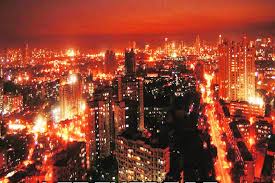INTRODUCTION:
Light pollution is one of the most rapidly intensifying types of environmental pollution. In urban regions, it creates a sky glow that could wipe out the stars. A study from 2016 that uncovered that 99 % of the population of the United States and Europe has not experienced natural light at night. Light pollution also has adverse effects on biodiversity. For instance, greater than 4 million migratory birds die every year in the United States due to collision with brightly illuminated towers and buildings as per the American Bird Conservatory.
WHAT IS LIGHT POLLUTION?
IMPACT OF LIGHT POLLUTION ON BIODIVERSITY:
HUMANS:
Light pollution affects the human body in numerous ways. It can cause various health issues such as redness in eyes, irritation in eyes, and in some serious cases, permanent darkness in eyes, etc. Excessive light due to light pollution also causes fatigue, headaches, anxiety, and stress. The production of melatonin which is the essential requirement for improving the human immune system might be affected due to long-term exposure to light pollution at night. It also impacts the navigation systems of railways, flights as well as automobiles. Light pollution could also constraint the military’s ability to conduct nocturnal training at bases around the country.
WILDLIFE:
The wildlife is also harmed by light pollution. Constant artificial night lighting disorients organisms accustomed to navigating in a dark environment. For instance, the disorientation of hatchling sea turtles emerging from the sandy beaches. Changes in light level may disrupt orientation in nocturnal animals. A quick increase in illumination causes a reduction in visual capability from which the recovery time may be minutes to hours for frogs. Birds can be confused and trapped by lights at night. Large numbers of nocturnally migrating birds are affected when atmospheric conditions bring them close to the lights. Many insects such as moths, bugs, beetles, lacewings, crane flies, hoverflies, caddisflies, midges, wasps, and crickets are attracted to lights. This attraction depends on the spectrum of light. The insect collectors use ultraviolet lights because of their attractive qualities to attract insects. Terrestrial arthropods vary in their response to lights. Some nocturnal spiders are repelled by light whereas others will exploit light if available.
INTERNATIONAL VIEW OF LAWS REGARDING LIGHT POLLUTION:
In the US, Washington D.C., and 18 states including Arizona, Arkansas, Colorado, Connecticut, Delaware, Florida, Hawaii, Maine, Minnesota, Maryland, New Hampshire, New Mexico, New York, Oregon, Rhode islands, Texas, Virginia, and Wyoming have laws to reduce light pollution. Most of these states have enacted the dark skies legislation. The International Dark Sky Association (IDA) instructs the public and verifies parks and other places that have acted to lessen their light emissions. The IDA sanctioned the first U.S. dark sky reserve in 2017.
THE URGENT NEED FOR LEGISLATION TO PREVENT LIGHT POLLUTION IN INDIA:
Although India has not yet reached the level of light pollution that has been seen in US and the European countries, however, the western regions of the Indo-Gangetic plains and the huge metropolitan regions are the brightest. The Thar Desert and the forested and somewhat less populated regions of India are among the limited regions in the country that still has unlighted skies. In West Bengal, Gujarat, and Tamil Nadu, outdoor brightness due to artificial lights increased from lower to higher levels over the last 20 years. Urban growth, industrial development, and air pollution have been the key players for escalating light pollution in these states. The loss of natural light due to extreme artificial light at night for India is three times faster than the global average as per a global study done in 2017. The municipal authorities of Mumbai and Mumbai Police have tried to administer some rules to prevent light pollution even in the absence of any legislation. For instance, the Brihanmumbai Municipal Corporation (BMC) ordered a hospital and gymkhanas along Marine Drive to switch off the high-intensity lights and billboards after 11 pm after receiving complaints from a Kalbadevi resident of Mumbai. Light pollution does not sound as alarming as soil, air, and water pollution that’s why people are unaware of this and there are no legislations or safety measures to prevent it in India.
CONCLUSION:
Light pollution is an internationally recognised problem. An inclusive diversity of environmental ramifications of artificial light have been recognised due to light pollution. To control this pollution some efficient methods have been characterised such as the utilization of shielding on lighting fixture to avert direct skyward light especially at low angles above the horizon, evading the use of higher lighting levels than strictly required for the job, and limiting illumination to the region where it is required and clocking it.
REFERENCES:
1. Jerry A Nathanson, “Light pollution” Britannica available at https://www.britannica.com/science/light-pollution (Visited on October 22, 2020).
2. Light Pollution, National Geography, available at https://www.nationalgeographic.org/article/light-pollution/ (Visited on October 22, 2020).
3. States Shut Out Light Pollution, NCSL, available at https://www.ncsl.org/research/environment-and-natural-resources/states-shut-out-light-pollution.aspx (visited on October 23, 2020).
4. Phil Cain “Slovenia takes dim view of light pollution” BBC NEWS available at https://www.bbc.com/news/world-europe-11220636 (Visited on October 23, 2020).
5. Manoj R Nair, “Why we need a policy on light pollution” Hindustan Times available at https://www.hindustantimes.com/mumbai-news/why-we-need-a-policy-on-light-pollution/story-JYZTzF5aMM5Xb4CXPXJKbO.html (Visited on October 24, 2020).
6. Sahana Ghosh, “Light pollution on the rise in India: Study” MONGABAY available at https://india.mongabay.com/2019/01/light-pollution-on-the-rise-in-india-study/ (visited on October 25, 2020).


